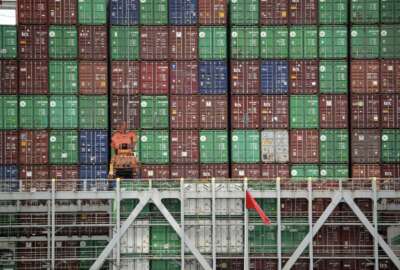Hubbard Radio Washington DC, LLC. All rights reserved. This website is not intended for users located within the European Economic Area.
New rules coming for contractors working on federal infrastructure projects
Companies leaders who want a piece of projects funded by last year's infrastructure bill, should pay attention.
Companies leaders who want a piece of projects funded by last year’s infrastructure bill, should pay attention. The White House is coming out with lots of new rules for the Build American, Buy American act aka BABA. For more on this, the Federal Drive with Tom Temin with Dan Ramish, Haynes-Boone procurement attorney.
Interview transcript:
Dan Ramish The BABA act is a new, as of last year with the [Infrastructure Investment and Jobs Act (IIJA)], a new statute that provides general applicability rules giving preferences to American produced products. And this is for all infrastructure projects funded by federal financial assistance. Now to step back for a second, Buy American laws have a long history in this country. The Buy American Act of 1933 was the original statute that introduced preferences for American made products and supplies. That statute, for those who are familiar with federal procurement contracts, the Buy American Act and Trade Agreements Act govern domestic preferences for contracts. Grants and cooperative agreements and other federal financial assistance are handled separately. They’re not subject to the federal acquisition regulations, they’re subject to the [Office of Management and Budget (OMB)] uniform guidance as it’s adopted by individual grant regulations of agencies. So this infrastructure money is coming through primarily state and local governments in the form of grants and other financial assistance. And those entities will then award contracts to construction companies. And these new rules under the BABA Act will govern as a floor for those projects, the use of American made iron and steel construction materials and manufactured products.
Tom Temin Right. So just to clarify, then, the contract will be with state agencies and maybe large city agencies, but the money will be from the federal government, probably through the Transportation Department, I’m guessing, but through grants to local entities who will then award contracts. And so because it’s ultimately federal money, then there are federal rules.
Dan Ramish That’s right. And there were some statutes actually referred to as, confusingly, the Buy America statute, no N. And these were separate statutes applying to different operating administrations of the Department of Transportation. So the Federal Highway Administration, the Federal Transit Administration, the Federal Railroad Administration, they each had their own statutes with separate rules that were similar, but not identical. But not all agencies were covered by this. The Buy America statutes covered transportation projects with DOT. Now, the BABA Act covers all agencies and all infrastructure projects funded with financial assistance. And notably, the DOT Buy America statutes, that predate the BABA, didn’t cover construction materials. Now we have the Infrastructure Act, $550 billion of infrastructure funding over five years. So the Biden administration wanted to ensure that we’re maximizing the use of American made goods. So that was the purpose of the BABA Act. And now OMB has introduced guidance to be added to the uniform guidance, that will tell state and local governments and ultimately contractors what they need to comply with to buy American infrastructure projects.
Tom Temin Got it. Now, this will obviously apply directly to people that are buying products to be put on a construction site and bolted and welded and screwed into a building, let’s say, or laid down underneath a bridge, whatever the case might be. But does it also back up, possibly to say, design and architectural firms who have to specify products and therefore they have to make sure that there is an American source for what it is they specify?
Dan Ramish Yeah. So the way it works, there will be an award term, so a contract clause that will go into the grants with state and local governments. And that requirement in the term, for the use of American made iron and steel construction materials and manufactured products, will then go into the contracts with construction companies, and construction companies will then have to pass on those requirements if they’re using architectural engineering support. And so down the line, if we’re dealing with commercial construction companies that haven’t dealt with some of these requirements before, they may not have processes in place for knowing their full supply chain. And so this will really involve closer examination of who is ultimately providing the supplies of materials that go into these projects.
Tom Temin We’re speaking with Dan Ramish. He’s a procurement attorney at Haynes-Boone. And that’s an important point, because a lot of iron and steel and engineered products, I-beams or whatever, pre-made trusses, you name it, might be manufactured in the United States, but the source of the raw materials, the steel in them, is very often foreign. Korean, for example, or Japanese. I don’t know what the latest top steel producing companies are, the last I checked it was Korea, but that’s a long time ago. So you have to really go back in the supply chain, even though you might be buying that truss from a fabricator in Georgia. You got to know where that steel came from that the fabricator used.
Dan Ramish Right. And state and local governments and construction companies are looking closely at these requirements as they evolve. And the proposed guidance, because those details will matter. And so the proposed guidance to be added to the uniform guidance includes information about what it even means to be produced in the United States for different types of construction materials, kind of what the manufacturing process entails. Everyone has a vested interest in that and how those definitions come together.
Tom Temin Do we know whether it goes back in the supply chain? Do the rules go back to ore, for example? Because ore might be mined elsewhere, and brought to the United States and then smelted or otherwise turned into metal here. So does that make it U.S. sourced metal? Or if the ore comes from overseas on a barge, some kind of a large ship, what is it?
Dan Ramish So for iron and steel, the manufacturing process starts from the initial melting phase and goes all the way through to coding. But as I say, the individual construction materials, the manufacturing process couldn’t be defined individually. And there’s a lot of debate over how that should be defined and what the requirements should be. There are also concerns about getting these materials. The federal government can say you have to use American made manufactured products, for example, but if the particular manufactured product you need for your infrastructure project is only made overseas, then you have to get a waiver. And the waiver process is receiving more scrutiny than it used to. And that’s by intention of the Biden administration. And actually, they’re continuing initiatives that started under the Trump administration emphasizing the use of American made products. But the practical effects of this, trying to spend all this money and follow the rules, it’s going to be very challenging. And some of the people that are going to have to follow the rules, new state and local governments, for example, that maybe aren’t used to these big infrastructure projects and new commercial construction contractors, they’ll have extra challenges because they’re not familiar with the framework.
Tom Temin Got it. Yeah. So therefore, they need somebody like you to check out to make sure they’re complying with the rules. But simply buying from a U.S. firm as your prime supplier will not cut it, because you need to know where the supply chain leads beyond the company that you buy the finished material from to go into that project.
Dan Ramish Right. And for manufactured products, there’s a components test as well. Not only does the manufactured product itself need to be manufactured in the United States, but 55% of the cost of the components has to be of components that are produced in the United States.
Tom Temin Right. So it’s not just raw materials and the construction framework stuff. I mean, if you’re using aluminum, well, aluminum is most of the bauxite comes from Arkansas, I think, or something, I don’t know. The biggest bauxite producer happens to be Australia, but the aluminum could be smelted here and then you’re ok. But computer systems, HVAC systems for buildings or control systems for bridges and lights, there’s a lot of technology in a bridge that you may not be aware of. That also has to be sourced in the United States and have U.S. components in it.
Dan Ramish That’s right. And it gets very complicated. The other major concern that trade experts have raised with the uniform guidance is coverage of the U.S. obligations under trade agreements. Now, this is a little bit different from the federal procurement contract context, because state and local governments are not mandatorily covered under trade agreements like the World Trade Organization Government Procurement Agreement. But many states and some cities and localities have opted into the WTO GPA and other trade agreements. And the uniform guidance doesn’t exempt instances where trade agreements may come into play. And there are concerns about upsetting our trading partners.
Tom Temin Yes, right. I mean, suppose some partners that I think come under exceptions, say Canada, I think Japan, maybe some of the EU countries might have technology that could go into a infrastructure project. You don’t want to rule them out, necessarily because of that concern you just mentioned.
Dan Ramish Yes. And also, if construction contractors aren’t able to use, say, European goods under the WTO GPA, then that makes it even more difficult to find the sources they need to do the projects.
Tom Temin I guess I’ll get into the bridge signal lighting tracking business and make everything here.
Dan Ramish Yeah, there you go. The problem is that it takes time for companies to move manufacturing operations to the United States. And so this is going to be a gradual process. And they’re going to be real growing pains in the practical implications here, trying to comply with the rules, while manufacturing processes change and things are very short, so to speak.
Tom Temin All right. So pay attention and know your supply chain. I guess the beauty of it is the heavier the material, like sheetrock, concrete, those kinds of things are all produced locally within 50 miles of whether consumed because they’re too expensive to ship. But the more refined and the more high tech it gets, probably the more you have to worry.
Dan Ramish I think that’s fair.
Copyright © 2024 Federal News Network. All rights reserved. This website is not intended for users located within the European Economic Area.
Tom Temin
Tom Temin is host of the Federal Drive and has been providing insight on federal technology and management issues for more than 30 years.
Follow @tteminWFED
Related Stories
Related Topics




